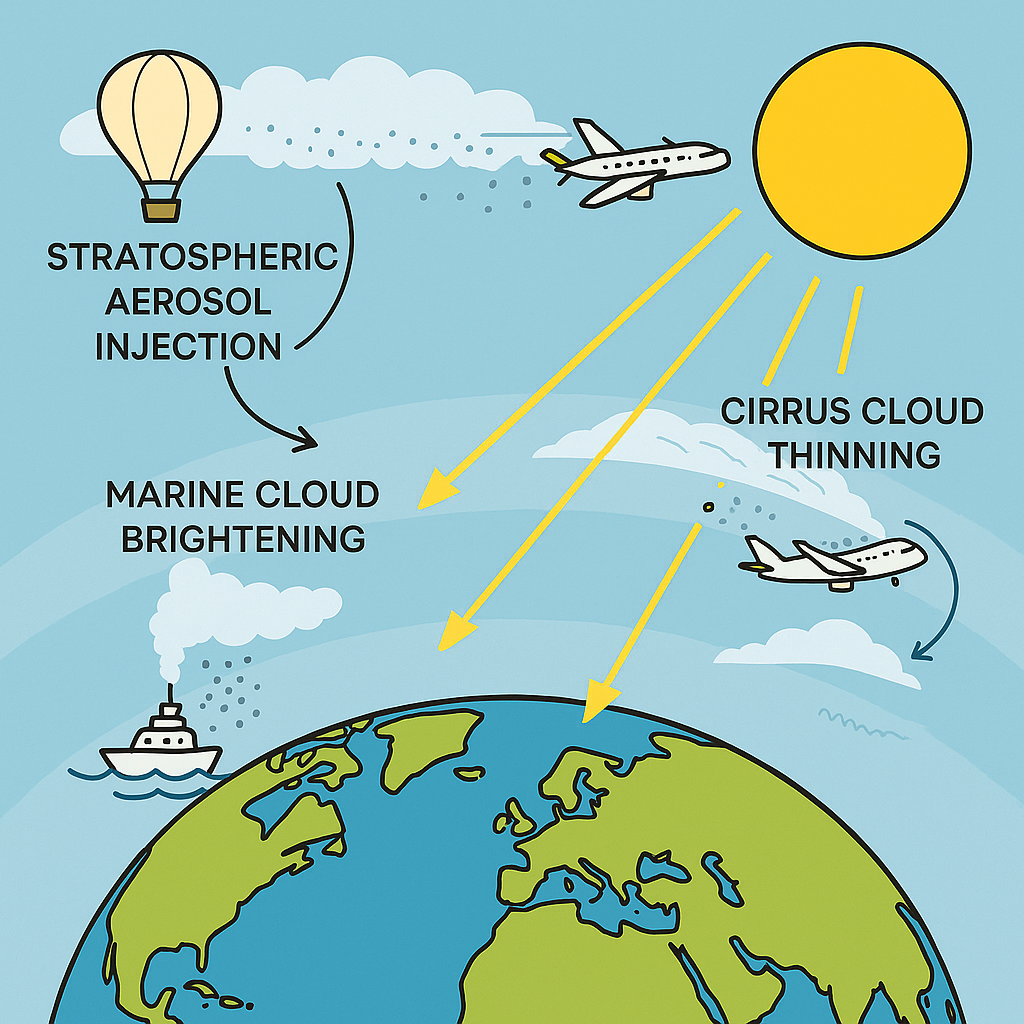
A Risky Experiment with Earth’s Future:
As the climate crisis intensifies—with heatwaves scorching continents and storms battering coastlines—scientists and policymakers alike are exploring ever more radical ways to buy time for the planet.
One such idea, solar geoengineering, proposes to deliberately reflect a fraction of incoming sunlight back into space. In the UK, the government’s High-Risk, High-Reward agency, ARIA, has earmarked roughly £56.8 million for small, carefully controlled outdoor trials of three techniques:
- Stratospheric Aerosol Injection (SAI), lofting tiny particles into the upper atmosphere to mimic the cooling effect of volcanic eruptions.
- Marine Cloud Brightening (MCB), spraying fine seawater droplets into low marine clouds to make them more reflective.
- Cirrus Cloud Thinning (CCT), seeding high-altitude ice clouds so that more longwave radiation can escape.
These pilot projects—sending milligram-scale puffs of dust or seawater into limited patches of sky for days or weeks—are purely research exercises. They won’t dim the sun in any meaningful way, nor cool the planet at scale. Instead, they aim to deepen our understanding of how aerosols and clouds behave, and how the climate responds.
Why Sun-Shielding Sounds Tempting:
Greenhouse gases already in the atmosphere will keep warming Earth for decades, even under aggressive emission cuts.
Unlike carbon removal—which pulls CO₂ from the air over years—solar geoengineering could lower global temperatures within months. In a world racing toward dangerous “tipping points” (such as irreversible ice-sheet loss), a rapid “thermostat dial” feels appealing.
The Hidden Costs of Dimmed Light:
Yet life on Earth depends on sunlight. Photosynthesis—the process by which plants, algae, and some bacteria convert light into chemical energy—anchors every food web on land and sea.
Even a small drop in sunlight can shrink plant growth, which ripples up the chain: fewer leaves means fewer herbivores, which means fewer predators.
Forests, our planet’s lungs, rely on both direct and diffuse sunlight. Intriguingly, after the 1991 Mount Pinatubo eruption plunged global temperatures by about 0.5 °C, the extra scattered light actually boosted canopy photosynthesis by up to 23% in some woodlands. But that “diffuse-light bonus” only comes with massive volcanic injections—and can’t be precisely tuned.
Marine life faces twin threats. Phytoplankton—the ocean’s microscopic plants—perform nearly half of all photosynthesis on Earth. Reduced sunlight could starve them, collapsing food chains from tiny zooplankton to whales. At the same time, geoengineering does nothing to reverse ocean acidification, which already dissolves shells and bleaches corals.
Lessons from Volcanic Eruptions:
Volcanoes offer real-world experiments on a planetary scale. The 1815 Tambora eruption triggered the “year without a summer,” causing crop failures and famine across Europe and North America. Smaller eruptions, like Pinatubo, cooled the planet for a few years but also disrupted rainfall patterns, leading to droughts in some regions. These natural analogues underscore how meddling with sunlight can yield unpredictable—and sometimes devastating—side effects.
Beyond the Science: Ethics and Governance:
Even if solar geoengineering proved technically safe, it raises thorny questions:
- Termination shock: If we ever rely on sun-shielding at scale and then abruptly stop—because of political shifts or technical failure—Earth would rebound with rapid warming, leaving little time for ecosystems or societies to adapt.
- Moral hazard: The promise of a tweakable thermostat risks weakening the global push to slash emissions—the very root cause of climate change.
- Unequal impacts: Sun-shielding won’t affect every region equally. Monsoon patterns, drought frequency, and rainfall distribution could all shift, fueling geopolitical tensions over “who gets to cool the sky”.
To navigate these challenges, experts call for transparent, inclusive governance: public disclosure of all research, rigorous environmental impact assessments, and international treaties that treat solar geoengineering as a global public good—never a unilateral tool.
A Complement, Not a Cure:
Solar geoengineering cannot remove CO₂, nor halt ocean acidification, nor heal heat-stressed ecosystems. At best, it buys time—time we must use to accelerate the renewable-energy transition, restore forests and wetlands, and overhaul agriculture and industry.
The UK’s forthcoming field trials mark an important step toward understanding whether sun-shielding could ever play a role in our climate toolbox. But they are just that: trials. They won’t dim the sun in any meaningful way, nor will they replace the urgent need for emission cuts.
Ultimately, the health of our planet depends on one simple truth: we must stop adding greenhouse gases to the atmosphere. Anything else—no matter how seductive—remains a high-stakes experiment with Earth’s future.
Works cited
- Experiments to ‘dim the Sun’ to be given green light by UK government, accessed May 12, 2025, https://www.manchestereveningnews.co.uk/news/uk-news/experiments-dim-sun-given-green-31495956
- Scientists Preparing Experiments to Dim the Sun – Futurism, accessed May 12, 2025, https://futurism.com/scientists-preparing-experiments-dim-sun
- Solar Geoengineering and Climate Change – Congress.gov, accessed May 12, 2025, https://www.congress.gov/crs-product/R47551
- Solar radiation modification: NOAA State of the Science factsheet – Climate.gov, accessed May 12, 2025, https://www.climate.gov/news-features/understanding-climate/solar-radiation-modification-noaa-state-science-factsheet
- Solar radiation modification – Wikipedia, accessed May 12, 2025, https://en.wikipedia.org/wiki/Solar_radiation_modification
- UK’s ARIA Announces £45m Funding for 21 “Climate Cooling” Research Projects | SRM360, accessed May 12, 2025, https://srm360.org/news-reaction/aria-45m-funding-21-climate-cooling-research-projects/
- 7 UK Geoengineering Experiments Transforming Climate Change – – Farmonaut, accessed May 12, 2025, https://farmonaut.com/united-kingdom/7-uk-geoengineering-experiments-transforming-climate-change
- Solar Geoengineering Landscape Analysis – The Salata Institute, accessed May 12, 2025, https://salatainstitute.harvard.edu/wp-content/uploads/2024/06/solar_geoengineering_scoping_study_v2.pdf
- Explainer: Six ideas to limit global warming with solar geoengineering – Carbon Brief, accessed May 12, 2025, https://www.carbonbrief.org/explainer-six-ideas-to-limit-global-warming-with-solar-geoengineering/
- The Risks of Geoengineering – Center for International Environmental Law | CIEL, accessed May 12, 2025, https://www.ciel.org/wp-content/uploads/2024/10/CIEL_briefing_The-Risks-of-Geoengineering_October2024.pdf
- Stratospheric aerosol injection – Wikipedia, accessed May 12, 2025, https://en.wikipedia.org/wiki/Stratospheric_aerosol_injection
- Stratospheric Aerosol Injection – Geoengineering Monitor, accessed May 12, 2025, https://www.geoengineeringmonitor.org/technologies/stratospheric-aerosol-injection
- New directions in solar geoengineering research – The Salata Institute, accessed May 12, 2025, https://salatainstitute.harvard.edu/new-directions-in-solar-geoengineering-research/
Post a comment
You must be logged in to post a comment.





